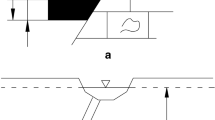Abstract
In order to exactly provide scientific basis for pressure dynamic balance control of working chamber of earth pressure balance shield (EPBS), study on optimal arrangement of pressure measurement points in working chamber was conducted. Based on mathematical description of optimal arrangement for pressure measurement points, fuzzy clustering analysis and discriminant analysis were used to divide pressure regions of nodes on bulkhead. Finally, the selection method of optimal measurement points was proposed, and by selecting d6.28 m EPBS as study object, the case study was conducted. By contrast, based on optimal arrangement scheme of pressure measurement points, through adopting weighted algorithm, the absolute error mean of equivalent pressure of working chamber is the smallest. In addition, pressure curve of optimal arrangement points presents parabola, and it can show the state of pressure distribution on bulkhead truly. It is concluded that the optimal arrangement method of pressure measurement points in working chamber is effective and feasible, and the method can provide basis for realizing high precision pressure control of EPBS.
Similar content being viewed by others
References
BABEBDERERDE S. Tunnelling machines in soft ground: A comparison of slurry and EPB shield systems [J]. Tunnelling and Underground Space Technology, 1991, 6(2): 169–174.
LECA E, DORMIEUS L. Upper and lower bound solutions for the face stability of shallow circular tunnels in frictional material [J]. Geotechnique, 1990, 40(4): 581–606.
LEE I M, NAM S W. The study of seepage forces acting on the tunnel lining and tunnel face in shallow tunnels [J]. Tunnelling and Underground Space Technology, 2001, 16(1): 31–40.
LEE I M, NAM S W, JAE H A. Effect of seepage force on tunnel face stability [J]. Canadian Geotechnical Journal, 2003, 40(2): 342–350.
ANAGNOSTOU G, KOVAR K. Face stability conditions with earth-pressure-balanced shields [J]. Tunnelling and Underground Space Technology, 1996, 11(2): 165–173.
BROERE W. Tunnel face stability new CPT application [D]. Delft: Delft University of Technology, 2001.
HUANG Zheng-rong, ZHU Wei, LIANG Jing-hua, QIN Jian-she. A study on the limit support pressure at excavation face of shield tunneling [J]. China Civil Engineering Journal, 2006, 39(10): 112–116. (in Chinese)
KIM S H, TONON F. Face stability and required support pressure for TBM driven tunnels with ideal face membrane-Drained case [J]. Tunnelling and Underground Space Technology, 2010, 25(5): 526–542.
YEH I C. Application of neural networks to automatic soil pressure balance control for shield tunneling [J]. Automation in Construction, 1997, 5: 421–426.
YANG Hua-yong, SHI Hu, GONG Guo-fang, HU Guo-liang. Earth pressure balance control for EPB shield [J]. Science in China Series E: Technological Sciences, 2009, 52(10): 2840–2848.
NEZAMI E G, HASHASH Y M A, ZHAO Da-wei, GHABOUSSI J. Simulation of front end loader bucket-soil interaction using discrete element method [J]. International Journal for Numerical and Analytical Methods in Geomechanics, 2007, 31: 1147–1162.
CLEARRY P W. DEM simulation of industrial particle flows: Case studies of dragline excavators, mixing in tumblers and centrifugal mills [J]. Powder Technology, 2000, 109: 83–104.
MELIS M AYNAR M J, MEDINA RODRIGUEZ L E. Discrete numerical model for analysis of earth pressure balance tunnel excavation [J]. Journal of Geotechnical and Geoenvironmental Engineering, 2005, 131(10): 1234–1242.
WU Li, QU Fu-zheng. Discrete element simulation of mechanical characteristic of conditioned sands in earth pressure balance shield tunneling [J]. Journal of Central South University of Technology, 2009, 16(6): 1028–1033.
WU Li, QU Fu-zheng, SUN Wei1, LI Shou-ju, LIU Chang. Discrete numerical model for analysis of chamber pressure of earth pressure balance shield machine [J]. Chinese Journal of Geotechnical Engineering, 2009, 28(5): 553–557. (in Chinese)
GAO Xin-bo, XIE Wei-xin. Advances in theory and applications of fuzzy clustering [J]. Chinese Science Bulletin, 2000, 45(11): 961–970.
PALIWAL M, KUMAR U A. Neural networks and statistical techniques: A review of applications [J]. Expert Systems with Applications, 2009, 36(1): 2–17.
YOON Y, JR G S, MARGAVIO T M. A comparison of discriminant analysis versus artificial neural networks [J]. Journal of the Operational Research Society, 1993, 44(1): 51–60.
Author information
Authors and Affiliations
Corresponding author
Additional information
Foundation item: Project(2007CB714006) supported by the National Basic Research Program of China
Rights and permissions
About this article
Cite this article
Liu, C., Qu, Fz., Li, Sj. et al. Optimal arrangement for pressure measurement points in working chamber of earth pressure balance shield. J. Cent. South Univ. 19, 1883–1891 (2012). https://doi.org/10.1007/s11771-012-1222-z
Received:
Accepted:
Published:
Issue Date:
DOI: https://doi.org/10.1007/s11771-012-1222-z




